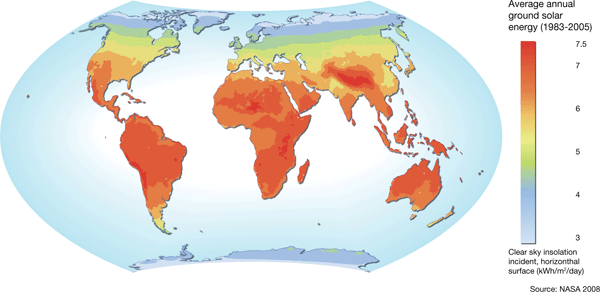
Basics of Solar Energy
Solar power is a widely growing energy generation source in today's world. The threat of our oil, coal, and natural gas reserves running dry as well as the more widely understood causes and effects of global warming require new, cleaner energy sources. Solar power is one of those possibilities.
On average, the earth's atmosphere receives 342 W/m2 of energy from the sun. (Maximum incident solar radiation outside the earth's atmosphere is 1353 W/m2, but this must be averaged over the whole earth.) The atmosphere, clouds and surface of the earth reflect about 31% of this energy back to space, but absorb the other 69%. The total amount of average energy hitting earth's surface, which could be used for solar power applications, totals 168 watts per square meter.
Different parts of the planet receive different average amounts of solar energy, or insolation, so it is important to know which part of the planet you live in if you are considering solar power.

Image from the United Nations Environment Programme and NASA
The above map shows the common solar energy received by the ground. Typically, more solar insolation is available for those who live closer to the equator, where the sunlight is more direct, however solar power is still possible and effective in other areas. Typically, in areas and times when solar power is not effective, other renewable energy sources, such as wind, can be used to supplement or instead of solar power, as wind is generally highest as night and in colder tundra-like areas.
Content Resources
Acknowledgment and Disclaimer
This material is based upon work supported by the National Science Foundation under Grant No. 0900940. Any opinions, findings, and conclusions or recommendations expressed in this material are those of the author(s) and do not necessarily reflect the views of the National Science Foundation.
